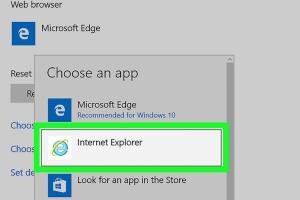How to Set Internet Explorer as Your Default Internet Browser: A Complete Guide

-
Quick Links:
- Introduction
- Why Use Internet Explorer?
- Steps to Set Internet Explorer as Default
- Troubleshooting Common Issues
- Case Studies: Internet Explorer Users
- Expert Insights on Browser Choices
- The Future of Internet Explorer
- FAQs
Introduction
In the world of web browsers, Internet Explorer (IE) often gets overlooked due to the rise of modern alternatives like Google Chrome and Mozilla Firefox. However, many users still prefer Internet Explorer for its unique features and compatibility with legacy systems. This article will guide you through the process of setting Internet Explorer as your default internet browser, ensuring you can utilize its capabilities seamlessly.
Why Use Internet Explorer?
Despite being overshadowed by other browsers, Internet Explorer offers several benefits:
- Compatibility: Internet Explorer is particularly suited for older web applications and enterprise environments.
- Familiarity: Many users have been using IE for years and find it comfortable and intuitive.
- Built-in Features: IE includes features like ActiveX controls, which might not be available in other browsers.
Steps to Set Internet Explorer as Default
Setting Internet Explorer as your default browser can vary slightly depending on your Windows version. Here’s a step-by-step guide for Windows 10 and 11:
For Windows 10
- Click on the Start menu and select Settings.
- Choose Apps and then select Default apps.
- Scroll down to the Web browser section.
- Click on the current default browser and select Internet Explorer from the list.
For Windows 11
- Open the Settings app via the Start menu.
- Go to Apps and click on Default apps.
- In the search box, type Internet Explorer and select it.
- For each type of file and link that you want IE to open, select Internet Explorer.
Troubleshooting Common Issues
Sometimes, users encounter issues while trying to set Internet Explorer as their default browser. Here are some common problems and solutions:
- Issue: Default browser changes back automatically.
- Solution: Check your system settings and ensure that there are no other applications trying to override your default browser settings.
For a complete troubleshooting guide, refer to the Microsoft support page: https://support.microsoft.com/en-us.
Case Studies: Internet Explorer Users
To provide context, we’ve gathered insights from users who have successfully integrated Internet Explorer into their daily routines:
Case Study 1: Corporate Environment
A large corporation using legacy systems found that switching back to Internet Explorer improved their workflow significantly, as many internal applications were designed to run exclusively on IE.
Case Study 2: Educational Institutions
Many schools prefer Internet Explorer for compatibility with educational software, which often relies on features unique to IE.
Expert Insights on Browser Choices
Industry experts weigh in on the importance of choosing the right browser for your needs:
"While newer browsers offer speed and security, Internet Explorer remains a solid choice for specific environments that require legacy support." - Technology Analyst
The Future of Internet Explorer
As Microsoft transitions its focus to Microsoft Edge, the future of Internet Explorer remains uncertain. However, it continues to have a dedicated user base that relies on its unique features.
FAQs
1. How do I know if Internet Explorer is installed on my computer?
You can search for "Internet Explorer" in the Start menu. If it appears, it is installed.
2. Can I still use Internet Explorer on Windows 10 or 11?
Yes, Internet Explorer is available on both Windows 10 and 11, although Microsoft recommends using Edge for better performance and security.
3. What should I do if Internet Explorer won't open?
Try restarting your computer or resetting Internet Explorer settings through the Advanced tab in Internet Options.
4. Is Internet Explorer safe to use?
While Internet Explorer is not as secure as modern browsers, it can still be safe if kept updated and used cautiously.
5. Will setting Internet Explorer as default affect my other browsers?
Yes, setting IE as the default will make it the primary browser for opening links and web content.
6. How can I reset Internet Explorer to its default settings?
Go to Internet Options > Advanced > Reset to restore IE to its original state.
7. Can I use Internet Explorer for online banking?
It's recommended to use a modern browser for online banking due to better security features.
8. What happens if I uninstall Internet Explorer?
If you uninstall IE, you will need to choose another default browser, and some legacy applications may not work properly.
9. How do I update Internet Explorer?
Updates for IE are included in Windows updates. Ensure your Windows is updated to get the latest version of IE.
10. Why do companies still use Internet Explorer?
Many companies rely on older web applications that only work with Internet Explorer, making it essential for their operations.
Random Reads